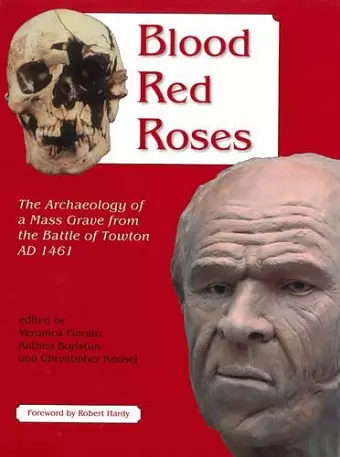Blood Red Roses
The Archaeology of a Mass Grave from the Battle of Towton AD 1461, second edition
Christopher Knüsel author Veronica Fiorato author Anthea Boylston author
Format:Paperback
Publisher:Oxbow Books
Published:12th Dec '07
Currently unavailable, our supplier has not provided us a restock date

The Battle of Towton in North Yorkshire, fought during the Wars of the Roses, was reputedly the bloodiest battle ever seen on English soil. In 1996 a mass grave of soldiers was discovered there by chance. This was the catalyst for a multi-disciplinary research project, still unique in Britain ten years after the initial discovery, which included a study of the skeletal remains, the battlefield landscape, the historical evidence and contemporary arms and armour. The discoveries were dramatic and moving; the individuals had clearly suffered traumatic deaths and subsequent research highlighted the often multiple wounds each individual had received before and, in some cases, after they had died. As well as the exciting forensic work the project also revealed much about medieval weaponry and fighting.
Blood Red Roses contains all the information about this fascinating discovery, as well as discussing its wider historical, heritage and archaeological implications. The second edition features new chapters by a re-enactor and a history teacher, which apply the research from the initial study to produce a veritable 'living history'.
... an impressive report which will stand as a model of its kind, superseding that of Thordeman (1939) who examined over a thousand skeletons in four mass burial pits from the battle of Wisby in 1361.' 'The value of this report lies in the thoroughness with which the burials are placed within the context of the battle and the skill with which the battle is set within the historic landscape.' -- Yorkshire Archaeological Journal Yorkshire Archaeological Journal The book is well produced and ... eminently readable. It is amply illustrated with many excellent diagrams and plates.' -- Assemblage Assemblage A thorough and elegant volume... The photographs are excellent, and Caroline Needham's drawings outstanding... Blood Red Roses is distinguished by its unusual combination of broad scope, painstaking detail and sensitivity.' -- Antiquity Antiquity This book tells the fascinating story of the piecing together of the evidence as to how the soldiers died...Not least this book is a medieval murder mystery. Draw your own conclusion from the wealth of evidence provided. -- BBC History Magazine BBC History Magazine This book presents a compelling study of the remains of those killed in the bloodiest battle on English soil. This well-written volume is for anyone interested in military history, medieval warfare, skeletal biology and bioarchaeology. The editors draw together a wonderful collection of superbly written essays that detail the various aspects of how skeletons should be studied, including the range of important contextual information that informs our understanding of the past. As a bioarchaeologist, I was especially impressed with the studies dealing with health and disease, traumatic injury, and activity reconstruction.' -- Clark Spencer Larsen, Ohio State University Clark Spencer Larsen, Ohio State University The archaeologists, anthropologists, pathologists, and historians of Bradford should be thanked for the care and skill they brought to this work. In this lucidly written and beautifully edited book, the scholars of Bradford have helped the dead of Towton to speak, to tell us who they were, and how they lived, fought, and died.' -- Journal of the American Medical Association 286, No. 21 Journal of the American Medical Association 286, No. 21 This book showcases the broader role of mortuary and forensic data as an adjunct to history, particularly since the nature and location of the mass grave raised several cultural-historical questions. These revolve around the non-Christian manner of interment, the particularly brutal manner of death (e.g. excessive and mutilating head trauma), and the 2-km distance of the grave from the traditional location of the battlefield.' 'The editors target both a professional and lay audience and succeed extraordinarily well, considering the breadth and depth of the subjects covered. Though professionally written, the text is not peppered with jargon or paradigm issues. Each chapter has a comprehensive bibliography. For the professional archaeologist/bioarchaeologist, the raw data for each individual are provided in tabular and/or descriptive format, either in the text or in an appendix. There is also careful description of the unconventional recovery technique (e.g., use of the electronic distance meter dovetailed with rectified vertical photography) and a thoughtful reassessment of archaeological field techniques effective for location battlefield sites (which typically have a long history of looting). For the avocational historian, there is a comprehensive glossary of pathological terms and several pages of simple line drawings of basic skeletal anatomy, with the bones and essential landmarks labelled. Additionally, each chapter provides a clear overview of the goals and of the data analysis, and concludes with an outline of the main points. Therefore, there is no ambiguity about the role particular research has in contributing to the total picture. This includes the role the Towton analysis plays in corroborating history and providing a point of departure for archaeological or forensic (e.g. massacre episodes) analyses.' -- American Journal of Physical Anthropology 117 American Journal of Physical Anthropology 117 This book is magnificently produced ... . It advances forensic analysis of burials and of mass graves, in particular, and points the way for future analysis of catastrophe cemeteries and of multi-disciplinary historical studies, generally.' -- The Ricardian 12 The Ricardian 12
ISBN: 9781842172896
Dimensions: unknown
Weight: unknown
294 pages